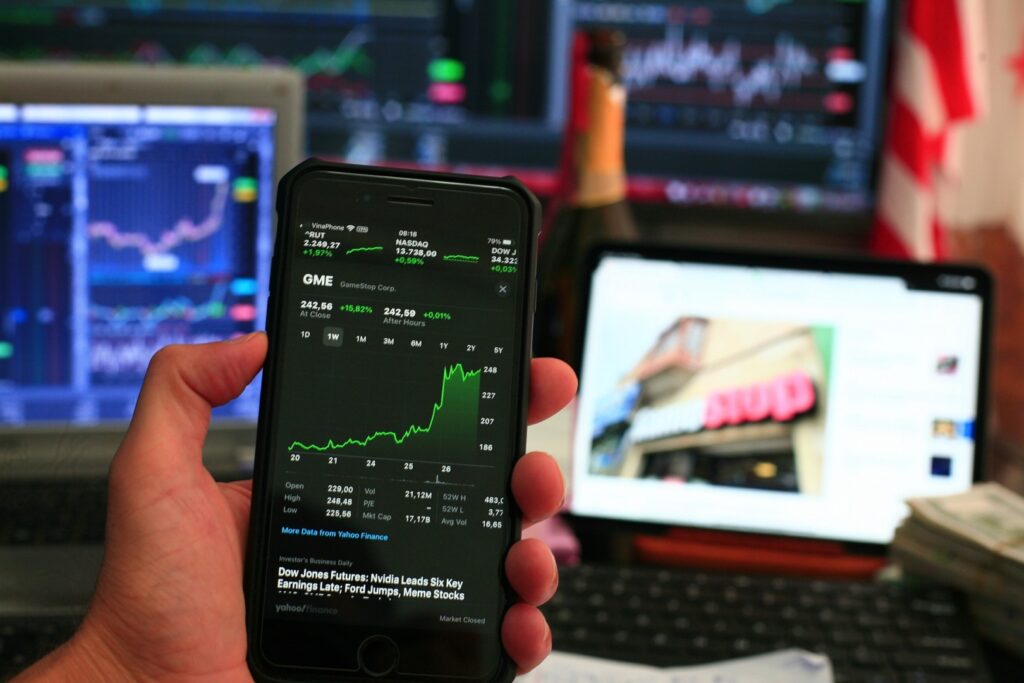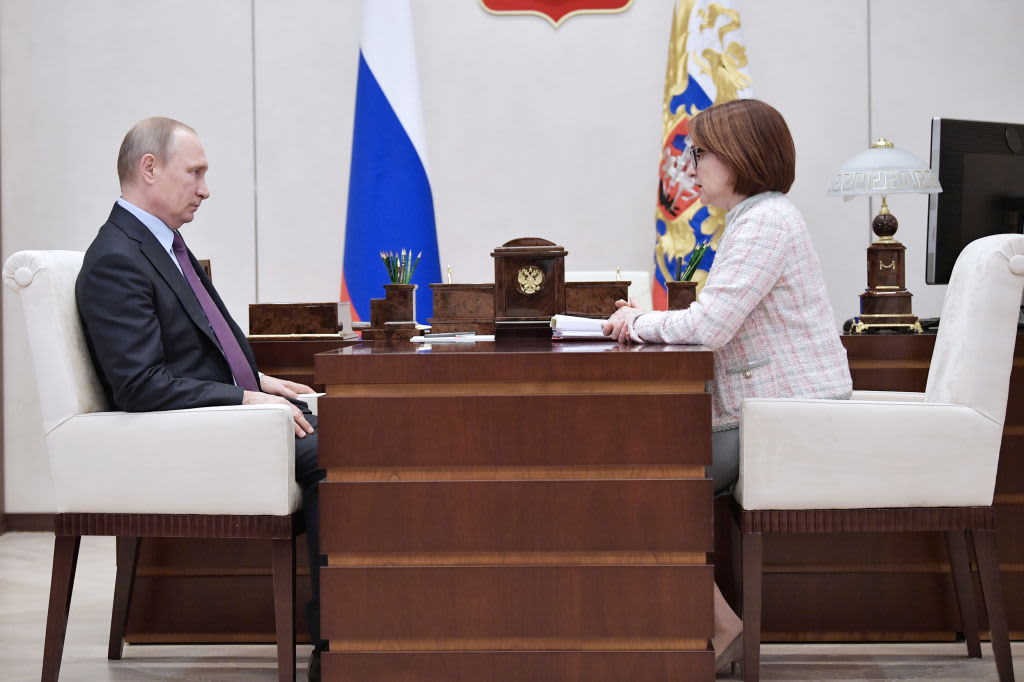- Russia’s central bank in an emergency meeting on Tuesday raised interest rates by 350 basis points to 12% in a bid to stem the rapid depreciation of the ruble.
- The surprise move came after an economic adviser to President Vladimir Putin wrote an opinion piece arguing that the acceleration of inflation and the currency’s fall were the result of “loose monetary policy”.
- Prior to the Kremlin’s intervention, the Bank of Russia blamed the country’s trade balance contraction on inflation and currency fragility.
Russian President Vladimir Putin (left) and Governor of the Russian Central Bank Elvira Nabiullina
Alexei Nikolsky \ TASS via Getty Images
Rising inflation and currency depreciation in Russia have highlighted the emerging rift between the Kremlin and the country’s central bank.
Russia’s central bank (CBR) in an emergency meeting on Tuesday raised interest rates by 350 basis points to 12% in a bid to stem a rapid decline in the value of the ruble currency, which fell to a 17-month low near 102 to the dollar on Monday.
The surprise move came after President Vladimir Putin’s economic adviser, Maxim Oreshkin, penned an opinion piece arguing that the recent acceleration in inflation and currency depreciation were the result of “loose monetary policy” and that the central bank “has all the necessary tools to normalize the situation.”
The bank said Tuesday’s emergency rate hike was intended to “reduce price stability risks” as “inflationary pressures are building,” with current price growth over the past three months at an annual average of 7.6% on a seasonally adjusted basis and outpacing core inflation. . In the same period it increased to 7.1%.
“The steady growth in domestic demand that exceeds the capacity to expand production amplifies the underlying inflationary pressure and affects the dynamics of the ruble exchange rate through higher demand for imports,” said the Central Bank’s Board of Directors.
Last week, the central bank halted its purchases of foreign currency in the local market until 2024 to reduce volatility, but this failed to stop the ruble’s decline. Russia often sells foreign currency to make up for the decline in oil and gas export revenues, and buys if it has a surplus.
Prior to the Kremlin’s intervention, the Bank of Russia blamed the country’s trade balance contraction on inflation and currency fragility, with Russia’s current account surplus falling more than 85% year-on-year from January to July.
“The exchange rate of the ruble is under state control,” Anatoly Aksakov, chairman of the State Duma Committee on Financial Markets, said on Telegram on Monday, according to Google Translate.
After taking concerted measures to reshape the Russian economy and lessen the impact of Moscow’s increasing economic isolation and punitive sanctions imposed on Western powers, the Kremlin and the Bank of Russia now apparently find themselves at odds over the causes of the currency problems.
Analysts pointed out that the government’s direct arming of the central bank with aggressive monetary policy measures was a sign of the problems the country’s economy was facing.
Agathe Demaris, director of global forecasts at the Economist Intelligence Unit, told CNBC that the central bank was correct in its previous assessment that the collapse in Russia’s current account surplus was the main factor behind the rise in inflation.
This is due to Western sanctions that limit oil and gas export revenues to Russia and fuel import costs. she told CNBC via email.
“The weakening of the ruble will reinforce this trend by further inflating import costs. In other words, the Russian currency has entered a vicious circle from which it will struggle to escape.”
The ruble initially fell to 130 to the dollar in February 2022 in the wake of Russia’s all-out invasion of Ukraine and subsequent sweeping imposition of Western sanctions. In response, the central bank implemented capital controls in order to stabilize the currency, eventually returning it to a range of 50-60 to the dollar by the summer of 2022.
Since then, the central bank has eased these capital controls in order to prop up the economy as sanctions take effect, which Damari said, along with a period of low interest rates, further entrenches a “vicious cycle” for the ruble.
“The combination of these factors shows that the Russian government’s room for maneuver is shrinking: the Russian leadership must now choose between fighting inflation or supporting growth – both key drivers of social stability,” she said.
“Higher interest rates will not be enough to stabilize the ruble, let alone help it rise against other major currencies. This is because the negative factors behind the currency’s weakness are largely outside the control of Russia’s central bank.”
She added that blaming the central bank had thus become an “easy tactic” for the Kremlin in the absence of any concrete options through which the situation could be improved.
Several news outlets reported on Wednesday that Russian authorities are considering the possibility of an imminent reinstatement of capital controls. This may take the form of a compulsory sale of foreign currency earnings to exporters, as an interest rate hike by the central bank only seemed to slow the currency’s deterioration.
Back to capital controls?
Stephanie Kennedy, economist at Julius Baer, agreed that the most likely scenario from here is for the CBR to double down on capital controls and the rule that exporters must convert their earnings from US dollars into rubles.
“Currency collapses are often the result of international investors becoming anxious or fleeing domestic capital. Sanctions and capital controls have left Russia cut off from the international financial system,” Kennedy said.
“Therefore, trading in the ruble, and especially against the US dollar, remains weak. Thus, it was not the speculative impulse that caused the currency to depreciate, but the headwinds from the relative flow of exports (which earn foreign exchange) versus imports (which have to be paid for with these gains).
Exports have fallen since the Group of Seven nations imposed a $60 cap on Russian crude oil in December, while imports have risen as the government seeks goods to prolong and boost its war effort.
Although the current account surplus is down more than 85% year-on-year from its peak in June 2022, it remains at an acceptable level and within its historical average, Kennedy noted, while the cheap currency raises the value of the ruble not only from Russia’s oil revenues, but also import costs.
Russian Deputy Prime Minister Andrei Belousov said in June that the value of the ruble between 80-90 to the dollar is ideal for the country’s budget, importers and exporters.
“While CBR may raise another 100 to 200 basis points to address the recession, aggressive walking as seen during the beginning of the war seems unlikely,” Kennedy said.
“High interest rates will often hurt domestic consumers and businesses, thus undermining the population’s support for the war even more.”
Therefore, Julius Baer expects to double capital controls and introduce the rule on exporters, but he believes that the ruble will remain around 92 against the dollar in three months and 95 in 12 months.
“While this implies an immediate rally, with a heavy load, the ruble is barely tradable and uncertainty about the outlook is high,” Kennedy said.

“Typical beer advocate. Future teen idol. Unapologetic tv practitioner. Music trailblazer.”



/cdn.vox-cdn.com/uploads/chorus_asset/file/24247717/lp_logo_3.0.jpg)



More Stories
GameStop and AMC Entertainment Share Spike Monday Afternoon: What’s Happening? – GameStop (NYSE: GME)
Red Lobster chain goes bankrupt after unlimited shrimp deal
Ethereum vs. Solana: Social hype can send the price of a single token soaring